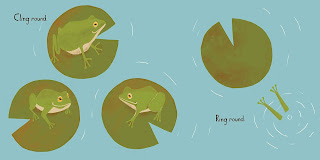Round
Written by Jennifer Ward and illustrated
by Lisa Congdon
Beach Lane Books, an imprint of
Simon & Schuster, 2020
Young children will enjoy looking
for all of the round things in the beautifully illustrated picture book,
“Round.”
The words are simple and
repetitive. The story begins:
“Up round. Down round.
Nature all around is round.”
The rest of the words are rhyming pairs, two words to each page.
“Coiled round,” with a picture of
a coiled snake.
“Foiled round,” along with a
picture of a fox looking at the snake slip away.
The story points out round things in spring and summer, then fall, and finally winter.
At the end, it sums up with a two-page spread showing much of what came before: the sun, flowers, mountains, deer, a rabbit, a tree, and a bird. The words say,
“Nature all around is …”
Then the book concludes with a
two-page spread of planets circling the sun, and the word, “Round!” in all
caps.
Lisa Congdon’s colorful illustrations are bold,
vibrant and beautiful. They have sharp edges against a solid background, giving
them a geometric look.
About the Author
Jennifer Ward is the author of many nature and nonfiction books for children, including “Mama Built a Little Nest,” illustrated by Steve Jenkins; “How to Find a Bird,” illustrated by Diana Sudyka; and “Feathers and Hair, What Animals Wear,” illustrated by Jing Jing Tsong. She writes from her home in Edwardsville, Illinois, where she enjoys the circular cycle of the seasons and is easily distracted by everything outside her windows, especially birds’ round eyes, the round flowers in her native gardens, and the round spots on the leopard frogs that splash in her round pond. Visit her at JenniferWardBooks.com.
About the Illustrator
Lisa Congdon is a fine artist and illustrator. She has written and illustrated several books for adults, including “A Glorious Freedom: Older Women Leading Extraordinary Lives;” “Whatever You Are, Be a Good One: 100 Inspirational Quotations;” and “The Essential Guide to Working Your Creative Magic.” Lisa is an avid cyclist, and loves spotting round things in nature. She lives in Portland, Oregon. Visit her at LisaCongdon.com.


















































